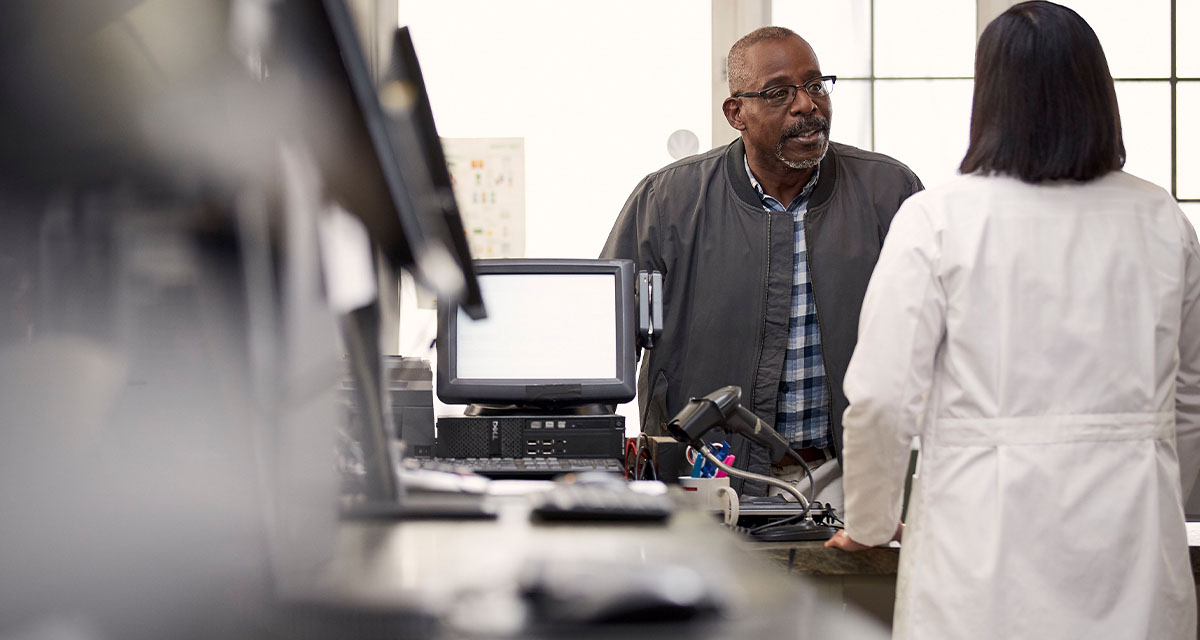Pharmacists: The Often-Overlooked Providers
Here’s something I never thought I’d say: For the past few months, I haven’t left the house to practice pharmacy.

While the role of the pharmacist has certainly evolved over the past few years, the progression got quite a boost in 2020. Though few anticipated COVID-19’s worldwide impact, pharmacists anticipated an evolution in their roles. In a 2018 survey, 78% of pharmacists said they anticipated a greater role in patient care within the next five years.AmerisourceBergen Pharmacy Check-Up, 2018 Of course, as we’ve often said in the wake of the new coronavirus, no one could’ve anticipated this rapid and dramatic shift.
Recent changes in state pharmacy board regulations have allowed for more remote work, streamlined workflows and shifting job roles and responsibilities. These changes could also present opportunities for pharmacy employees to better serve patients, especially during a time when patients are relying on pharmacists more than ever.COVID-19 and Medication Access, CoverMyMeds, 2020 With providers' offices not as accessible this year due to shutdowns and stay-at-home orders, patients were more often in front of their pharmacist for health-related questions. Seventy-two percent of patients said they regularly asked their pharmacist questions about medications.CoverMyMeds Patient Survey, 2020
To empower pharmacists to be the best provider they can for patients, a few areas need continued improvement.
Rerouting Pharmacy Roles
Much of a pharmacists’ responsibilities don’t have to happen within the actual dispensing pharmacy — answering patient and provider phone calls, communicating with insurance companies and data entry can all be done remotely. As a member of the State of Ohio Board of Pharmacy, I’ve been pushing for remote pharmacy work since I joined seven years ago. Historically, the hesitation to allow remote work has centered on data safety since we’re dealing with protected health information (PHI).
Then COVID-19 happened. To prevent the virus's spread and promote social distancing, many pharmacy boards across the country approved emergency orders allowing remote working.
So, what changed? Boards recognized that pharmacies are now working on cloud-based virtual servers instead of a physical terminal within a building, which allows for more secure access. The fear of the unknown kept us from enabling this option for so long, but we’ve now been operating this way for nine months with little to no consequences.
Pharmacists seem to be more productive and happier because their quality of life has improved. By routing managerial tasks and phone calls that don’t need to occur face-to-face to remote workers, we free up workers physically necessary in pharmacies to count drugs, answer medication questions or — becoming ever more relevant — administer vaccines and COVID-19 tests. The move has also enabled more around-the-clock services such as data entry. This not only frees up time for necessary communication during the day, but it also allows many pharmacy employees, such as technicians, to work shifts that better fit their family schedules.
More than Lick, Stick and Pour
The traditional view of a pharmacist’s job tasks — licking a label, sticking it on the bottle and pouring in pills — are starting to go away as patients realize all of the pharmacy’s possibilities. During the early 2018-2019 flu season, pharmacists were responsible for over a third of the vaccines administered.Guidance for Licensed Pharmacists and Pharmacy Interns Regarding COVID-19 Vaccines and Immunity under the PREP Act, US Department of Health and Human Services, 2020 Now, many retail pharmacies offer a myriad of available vaccinations and health screenings. With new legislation from the Department of Health and Human Services, qualified pharmacy interns and technicians can now also administer certain vaccines.Pharmacy interns and techs who meet HHS requirements can administer childhood, COVID-19 vaccines, APhA, 2020
In a recent CoverMyMeds survey of pharmacists, over two-thirds said they’ve taken on new job responsibilities since COVID-19.CoverMyMeds Pharmacist Survey, 2020 These included patient follow-up calls for refills and adherence, a prescription home delivery program and finding new ways to help patients save money.
To further help patients, pharmacists simply need more time. Retail pharmacists are often patients' most accessible healthcare practitioner. So, how can we continue to redistribute behind-the-scenes barriers to keep pharmacists in front of patients?
The pharmacist measuring stick also needs to change metrics. Often key performance indicators for pharmacists include the number of prescriptions verified each day. But as pharmacists administer more flu shots, perform more COVID-19 tests and take more time to educate patients, those prescription volumes are going to drop. The day-to-day measure of a pharmacist should no longer be based on prescription volume but instead on the qualitative value of their role as a practitioner.
Billing requirements, or the inability to be billed as a provider more specifically, also act as a barrier for pharmacists. While collaborative agreements with doctors can enable pharmacists to help manage certain patients, pharmacists still can’t write or change prescriptions because pharmacies can’t bill insurance companies for their information. Pharmacists must continue to lean on doctors’ licenses in many situations.
Better Pharmacy Transparency
As pharmacists continue solidifying their role on the patient care team, they’ll need tools to effectively field patient questions and problem-solve affordability issues. They also need to stay in workflow: 82% of pharmacists said it’s important or very important to integrate their ideal tool into their current pharmacy dispensing system.CoverMyMeds Pharmacist Survey, 2020
Keeping systems integrated is especially important as work becomes more remote and real-time status updates become critical. Even though communication to and from providers offices and insurance companies can be routed to remote workers, it’s still the most challenging part of the job, and most often done over the phone.CoverMyMeds Pharmacist Survey, 2020 In our pharmacist survey, which included a wide variety of pharmacy roles, 83% of respondents said they handle rejected insurance claims daily.CoverMyMeds Pharmacist Survey, 2020 That becomes a big piece of the workload if some roles move remote and others are lightened of this burden to work more closely and directly with their patients.
When asked about their ideal tool, an overwhelming majority of pharmacists said they’d want PA status and insurance rejection information to be integrated.CoverMyMeds Pharmacist Survey, 2020 And with 37% of patients unaware of drug manufacturer cost assistance programs, it makes sense that 83% of pharmacists said they’d also want patient education materials in a tool.CoverMyMeds Patient Survey, 2020,CoverMyMeds Pharmacist Survey, 2020
More than half of patients surveyed said they asked their pharmacist about cheaper alternatives when their prescription costs too much.CoverMyMeds Patient Survey, 2020 And while price transparency and payment options should be a part of pharmacist tools, patient empowerment tools further upstream in the medication access journey could be incredibly useful. Technology can help facilitate productive conversations in all areas of the pharmacy workflow, from prescription intake to pickup.
Pharmacists have truly stepped up to the plate in a pivotal year for healthcare. And the role will continue to lead the charge in patient advocacy as COVID-19 vaccines become the issue du jour in 2021. Streamlining administrative tasks and processes with technology will be critical to clear pharmacists’ path to their ideal role on the patient care team.
To learn more about the changing roles of pharmacists, read "Looking Back at the History of Pharmacies."
The latest healthcare insights, floated right to your inbox.





